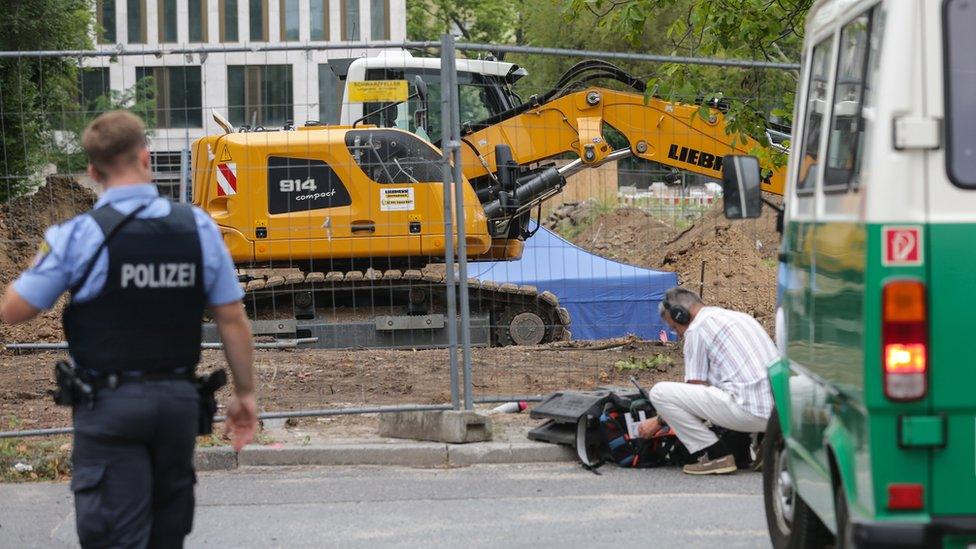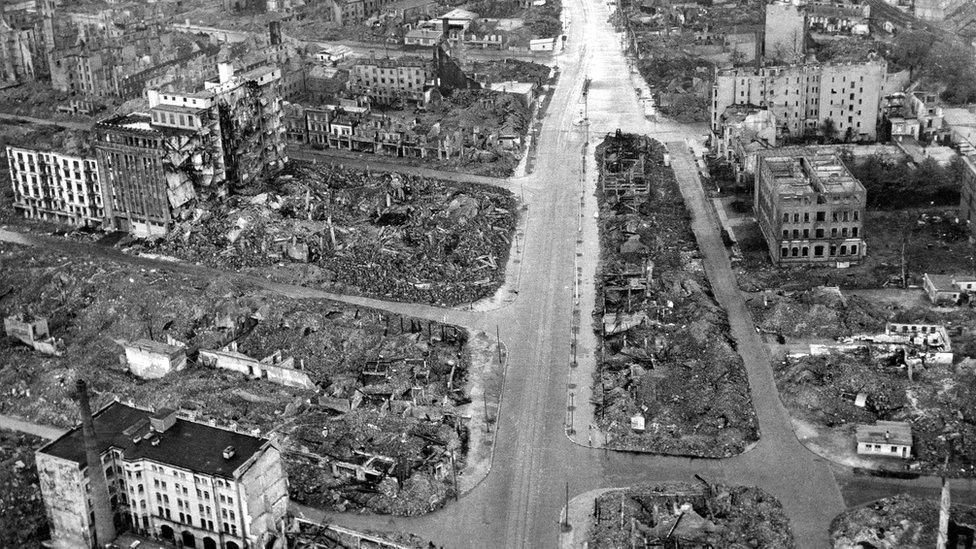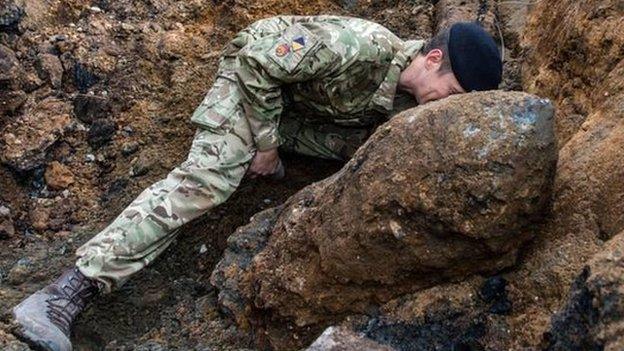Frankfurt to evacuate 70,000 after British WW2 bomb found
- Published

The British bomb was found on Wismarer Strasse, which is close to the city centre
German police will evacuate about 70,000 people from their homes on Sunday after an unexploded World War Two bomb was discovered in Frankfurt.
It will be one of the biggest operations of its kind carried out in Germany since the war.
The 1.4 tonne British bomb, nicknamed "blockbuster" during the war for its ability to wipe out whole streets, was found near Goethe University Frankfurt.
The university, the central bank and hospitals will also be evacuated.
Police said the bomb was a HC 4000, a type used in air raids by British forces.
It was found on Wismarer Strasse, which is close to the city centre and 2.5km (1.5 miles) north of the main shopping area in the city.
How dangerous are unexploded bombs?
Officers are guarding the site and say there "is currently no danger".
Bomb disposal experts who examined the bomb said the massive evacuation could wait until the weekend.
"We are still working on the modalities of the evacuation plan," a spokeswoman for Frankfurt police said.
Unexploded bombs are regularly found buried in Germany.
More than 20,000 people will be evacuated in the western city of Koblenz on Saturday after a World War Two bomb was discovered.
In May, about 50,000 people in Hannover were forced to leave their homes while experts defused three British bombs.

The ruins of Hamburg after bombing by the RAF in 1945
How many unexploded bombs are there in Germany?
On average about 2,000 tonnes of unexploded ordnance is found each year in Germany. It's estimated that about half the 2.7 million tonnes of bombs dropped by Allied powers during World War Two landed on German soil (compared to about 74,000 tonnes of bombs dropped on the UK by Germany). Many of the bombs were equipped with malfunctioning time-delay fuses, and many never went off.
Adding to the problem are Russian artillery shells, German hand grenades and anti-tank mines, as well as Russian munitions from training facilities in post-war East Germany.
The problem is so widespread that Germany has a bomb-disposal unit, the Kampfmittelbeseitigungsdienst (KMBD), dedicated to the problem. Its technicians are among the busiest in the world, deactivating a bomb every two weeks or so - and they estimate their work will continue for decades to come.
Do the bombs pose a real threat?
Dozens of bomb-disposal technicians and hundreds of civilians died from uncontrolled explosions in the decades after the war. The rate of fatalities has slowed since, with 11 technicians said to have been killed in Germany since 2000.
But experts warn that the devices that remain could be getting more unstable, as the munitions age and their fuses grow more brittle, and as bombs are discovered in more built-up, harder-to-reach areas.
The problem is also worse in certain parts of Germany.
Oranienburg, just outside Berlin, has the dubious distinction of being the "most dangerous town in Germany". Under Adolf Hitler, it contained an armaments hub, aircraft plant, railway junction and a nuclear research facility - so it was a key target for the Allies, who gave it an aerial pounding. Almost 200 bombs have been defused in the town since the end of the war, and residents are well-drilled in the evacuation procedure. But with experts estimating that some 350-400 bombs remain buried, the task is far from complete.
Other WW2 bombs recently discovered in Germany
May 2017: 50,000 people were evacuated from Hannover while three British-made bombs were defused
December 2016: More than 50,000 evacuated in Augsburg over 1.8-tonne British explosive
May 2015: 20,000 people in Cologne forced to leave their homes after a one-tonne bomb was discovered
January 2012: A construction worker was killed when his digger hit an unexploded bomb in Euskirchen
December 2011: 45,000 people were evacuated from Koblenz - half the total population - after two bombs were found in the riverbed of the Rhine
June 2010: Three members of a bomb disposal squad were killed in Göttingen during an operation to defuse a bomb found on a building site
- Published25 December 2016

- Published27 May 2015

- Published11 August 2015

- Published28 August 2012
